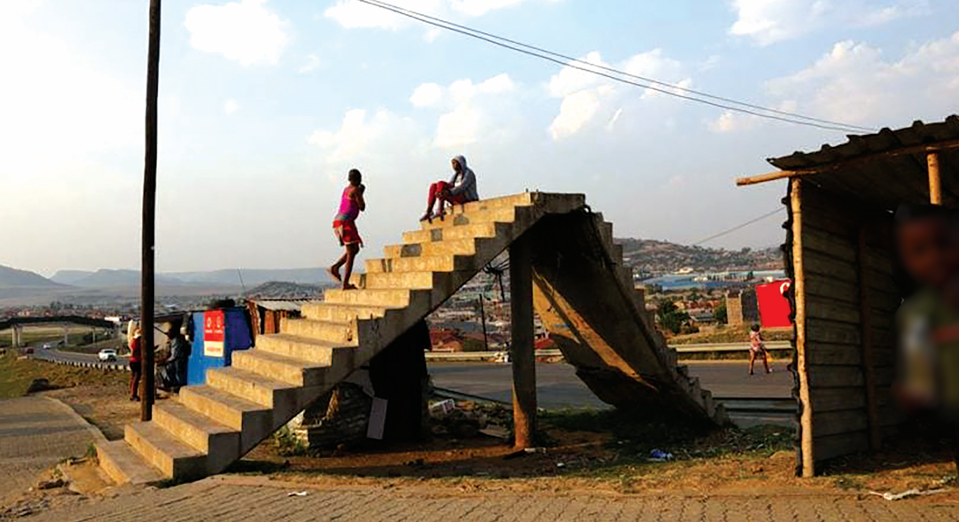A new African Development Bank report reveals the stark reality facing Lesotho as the Mountain Kingdom struggles with persistent poverty, inequality, and a failing transition to higher-value economic activities
Behind Lesotho’s picturesque mountain landscapes lies a sobering reality that has been laid bare in the new African Development Bank’s (AfDB) newly released Country Strategy Paper for 2025-2030.
The comprehensive report published in September 2025,paints a troubling picture of a nation trapped in a cycle of poverty, inequality, and economic stagnation, where half the population lives below the poverty line and the promise of development remains frustratingly out of reach.
The report presents the Bank Group’s Country Strategy Paper (CSP) for Lesotho for the period 2025-2030. It analyses recent political and socio-economic developments and outlook, presents the lessons learned, and defines the strategy that will guide the AfDB’s support to Lesotho during that period.
The report revealed that Lesotho’s overarching development challenge “has remained unchanged since the previous CSP 2020-2024,” the slow progress towards higher value-added economic activities.
This fundamental weakness has held back economic diversification and structural transformation, leaving the kingdom vulnerable and its people struggling.
The report’s statistics speak to a nation deeply divided along urban-rural lines. While overall poverty has declined from 56.6 percent in 2002 to 49.7 percent in 2017, this modest progress masks a stark disparity.
Urban poverty has fallen significantly to 28.5 percent from 41.5 percent, driven by increased formal employment linked to higher education attainment and expanded social protection programs.
Rural Lesotho, however, tells a different story. Rural poverty has barely budged, dropping only marginally to 60.7 percent from 61.3 percent over the same period. The report attributes this stubborn persistence to “high dependence on rainfed subsistence agriculture and falling remittances from South Africa,” a double blow that has left rural communities trapped in poverty.
Inequality in Lesotho is striking. The report said Lesotho ranks as the eighth most unequal country out of 76 nations, with a Gini Index score of 44.9. This places the kingdom among the world’s most economically divided societies, where wealth and opportunity remain concentrated in the hands of a few while the majority struggle to make ends meet.
A youth population awaiting economic opportunity
Another troubling statistic is youth unemployment. With young people aged 15-35 making up about 60 percent of the total population, Lesotho should be capitalising on this demographic dividend. Instead, the unemployment rate among youth stands at a staggering 38.9 percent in 2024.
“The labour market continues to offer limited formal job opportunities, especially for unskilled and rural youth, resulting in a significant skills mismatch,” the report states.
The education system bears much of the blame, struggling to equip young Basotho with market-relevant skills. Only 30 percent of students transition from primary to secondary education, hampered by factors including poverty and long travel distances to schools.
For young men, the crisis is particularly acute. They face persistently high unemployment with limited opportunities in the domestic economy to replace the loss of mining jobs in South Africa. Many returning migrants lack the skills demanded by Lesotho’s labour market, contributing to long-term joblessness.
Young women face their own set of challenges. Despite Lesotho achieving full parity in education attainment, the kingdom has closed only 49.4 percent of the wage gap for similar work. Women constitute almost half (47.4 percent) of the labour force but are relegated to unsecure, low-paying jobs in the informal sector, with an unemployment rate of 30.7 percent.
The disconnect between education and employment opportunities represents one of Lesotho’s most critical failures. Despite a high adult literacy rate of 82 percent, the education system remains poorly aligned with labour market needs. Limited vocational and technical training contributes to a significant skills mismatch that leaves young people educated but unemployable.
Underutilised ICT sector
The report identified a glimmer of hope in an unexpected sector. The underutilised ICT sector, with internet penetration at just 31 percent, offers strong potential for job creation, skills development, and digital entrepreneurship.
Targeted investments in digital literacy and ICT infrastructure could unlock new opportunities, particularly for youth and underserved communities.
Lesotho’s health indicators paint a grim picture of a healthcare system under strain. Life expectancy stands at just 57.8 years, maternal mortality reaches 566 per 100,000 live births, and the doctor-to-population ratio is a meager 0.9 per 10,000 people.
There have been notable successes, particularly in combating HIV/AIDS. By 2022, 94 percent of the population living with HIV knew their status, and 86 percent were receiving treatment, achievements that deserve recognition in a region devastated by the epidemic.
However, the nutrition crisis threatens to undermine future generations. Stunting affects 34.6 percent of children under five – higher than the African average of 30.7 percent. The economic cost is devastating: Lesotho loses USD 161 million annually (5.3 percent of national income) due to malnutrition, with stunting alone costing USD 137 million (4.6 percent of national income).
The government is pursuing Special Economic Zones and a national industrial policy to revive declining industrial performance, but the challenges are formidable. Poor road connectivity, unreliable electricity and water supply, outdated regulations, a small domestic market, low export diversification, and dependence on trade preferences have all contributed to industrial stagnation.
South Africa’s economic slowdown has reduced remittances and foreign investment, while increased competition in garment exports has caused factory closures. The linkages between Small, Medium and Micro Enterprises and large exporters remain minimal, limiting opportunities for local businesses to participate in export markets.
A private sector struggling to thrive
The private sector, which should be the engine of economic growth and job creation, remains small and faces structural challenges. Dominated by SMMEs, it operates in a weak business environment. The informal economy contributes about 30percent of GDP and employs over 50 percent of the workforce, mainly in subsistence agriculture under precarious and unregulated conditions.
The COVID-19 pandemic exacerbated these vulnerabilities, leading to the closure of many foreign-owned factories. Foreign direct investment net inflows declined sharply from 1.4 percent of GDP in 2020 to -1.2 percent by end-2023, reflecting the deteriorating investment climate.
According to the World Bank’s October 2024 Business Ready assessment, Lesotho performs well in Business Entry (76 percent), Labor (63 percent), and International Trade (61 percent) but scores poorly in Market Competition (26 percent), Business Solvency (37 percent), and Business Location (46 percent) due to lagging digital procurement, limited case management systems, and lack of energy efficiency standards.
Neglected agricultural sector
Agriculture remains key to poverty reduction, providing subsistence to 80 percent of the population. Yet the sector is constrained by poor farming methods and climate extremities. The El-Niño induced dry spells during the 2023/24 agricultural season reduced the area planted by 32 percent compared to 2022/23, leading to the lowest yields since 2018/19. About 33 percent of the total population is estimated to be food-insecure for the 2024/25 consumption year.
The cancellation of the USD 300 million Millennium Challenge Corporation compact in May 2025, which was meant to invest in rural irrigated high-value crop horticulture, has dealt a significant setback to the agriculture sector, stalling anticipated progress in productivity and rural transformation.
Meanwhile, the AfDB’s new Country Strategy Paper for 2025-2030 aims to support Lesotho in accelerating progress towards high value-added production. The strategy focuses on two priority areas: developing sustainable and quality infrastructure to promote industrialisation, and strengthening institutional and human capacities for improved public sector efficiency and enhanced competitiveness.
“The objective of the Bank’s new CSP 2025-2030 for Lesotho is to support the country accelerate progress towards high value-added production. This is expected to facilitate economic diversification and lay the foundation for private sector led inclusive and resilient growth, and structural transformation.
“To achieve this, the CSP focuses on two Priority Areas: (i) Developing sustainable and quality infrastructure to promote industrialisation; and (ii) Strengthening institutional and human capacities for improved public sector efficiency and enhanced competitiveness. The CSP selectively covers four sectors: energy, ICT and water, added at the request of the government following the cancellation of Millennium Corporation Challenge Compact II support in May 2025, under Priority Area I, and economic and financial governance under Priority Area II.
“Under Priority Area I, the Bank will support Lesotho’s ambition of expanding access to sustainable and quality infrastructure. To maximize developmental impact, and in response to CODE’s guidance, the Bank will prioritize integrated development operations to focus Lesotho’s limited ADF resources on catalytic multi-sectoral interventions. Under Priority Area II, the Bank will consolidate its previous and ongoing work in strengthening public service delivery and enhance institutional and human capacities for effective to implementation of NSDP II.
“Bank support under Priority Area II will aim to improve the institutional and regulatory environment for a more effective public sector and an enabling private sector environment for a competitive private sector, thereby complementing Bank support under Priority Area I, which aims to reduce the cost of doing business.”
Meanwhile, the Board of Directors of the African Development Bank Group has since approved $209 million (about M3.70 billion) for the Country Strategy Paper (CSP) for Lesotho, to accelerate the country’s transition toward economic diversification, resilience, and inclusive growth over the next five years.
“Lesotho stands at a critical juncture,” said Moono Mupotola, the Bank Group’s Deputy Director General for Southern Africa and Country Manager for Lesotho in announcing the funding.
“This comprehensive strategy leverages the country’s abundant water resources, strategic location, and demographic dividend to unlock new pathways for inclusive growth and economic diversification.”
Summary
- A new African Development Bank report reveals the stark reality facing Lesotho as the Mountain Kingdom struggles with persistent poverty, inequality, and a failing transition to higher-value economic activities.
- The comprehensive report published in September 2025,paints a troubling picture of a nation trapped in a cycle of poverty, inequality, and economic stagnation, where half the population lives below the poverty line and the promise of development remains frustratingly out of reach.
- This places the kingdom among the world’s most economically divided societies, where wealth and opportunity remain concentrated in the hands of a few while the majority struggle to make ends meet.

Authored by our expert team of writers and editors, with thorough research.





